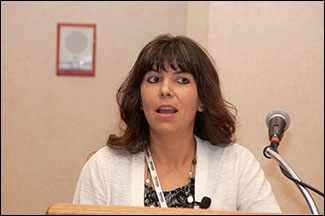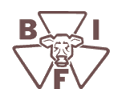Evaluating the Nutrient Profile of Beef
It is possible to genetically change the nutrient profile of beef. The question is should we?
by Kasey Brown, associate editor, Angus Journal®
LINCOLN, Neb. (June 20, 2014) — The nutrient profile can be changed genetically in beef due to heritability of mineral and micronutrient contents of the muscle, Raluca Mateescu, associate professor of animal science at the University of Florida, told attendees of the 2014 Beef Improvement Federation (BIF) Annual Meeting & Research Symposium in Lincoln, Neb., June 18-21, 2014.

Raluca Mateescu, associate professor of animal science at the University of Florida, said that high heritabilities were also found in micronutrient content of beef, with creatine at 0.43, carnosine at 0.38 and anserine at 0.53.
Consumers indicated in the 2014 Food and Health survey that healthfulness is the third main reason in determining their food purchases, and it is rapidly approaching price in importance, she said. Many in the United States have an issue with being overweight and undernourished. Many of the nutrients that are not met in the recommended daily amount by 30% or more include iron, zinc, vitamin B6 and Vitamin B12.
She referenced the Beef Healthfulness Project, which looked at three Angus herds in Iowa, Oklahoma and California and encompassed 2,285 head of cattle. Heritabilities were found in mineral composition of beef, with iron at 0.54, zinc at 0.09, magnesium at 0.06, and sodium 0.18. A recommended 3.5-ounce (oz.) serving of beef now provides 8%-18% of the recommended daily allowance of iron, 26% of zinc, 10% of potassium and 28% of phosphorus. There is a strong and positive genetic correlation between iron and zinc, she added.
Mateescu said that high heritabilities were also found in micronutrient content of beef, with creatine at 0.43, carnosine at 0.38 and anserine at 0.53. Additionally, beef is one of the best dietary sources of carnitine, which is an essential nutrient in fatty acid oxidation and has beneficial effects on exercise capacity. Creatine is important to muscle energy metabolism and can enhance muscle performance. Carnosine has significant antioxidant properties, and anserine is believed to be a possible antioxidant.
Beef is already a healthy component to the human diet, she said. It is possible to genetically change the nutrient profile of beef, but should we? Mateescu recommended increasing the iron concentration in beef. This could address the iron deficiency in many humans and help aging adults fight the risk of sarcopenia, related to iron and zinc deficiency. The beef industry could benefit from increase iron through improved color stability and shelf life at the retail display. There is also significant positive genetic correlation to improving beef flavor.
People get their nutrition information from health professionals, according to the 2014 Food and Health Survey. Mateescu said this is good news because health professionals are generally receptive to research documenting the meat consumption/health relationship. She recommended that the beef industry focus on research designed to document the relationship between meat consumption and specific health benefits, and to develop consumer education programs to promote the health and nutritional benefits of beef.
Using a Manhattan plot, she showed research that had identified SNPS and chromosomal regions associated with mineral concentration. She suggested that the industry develop the genetic or management tools needed to increase the components with positive health consequences and reduce those with negative health consequences.
The 2014 BIF Annual Meeting & Research Symposium was hosted by the University of Nebraska–Lincoln, the U.S. Meat Animal Research Center and the Nebraska Cattlemen June 18-21 in Lincoln, Neb. The Angus Journal and LiveAuctions.tv provide comprehensive online coverage of the event at www.BIFconference.com. Visit the Newsroom for summaries, proceedings, PowerPoints and audio of the sessions; the Awards page for announcements of award winners; and the Photos page for galleries of photos from the meeting and the tours.
Editor’s Note: This summary was written under contract or by staff of the Angus Journal®.Through an agreement with the Beef Improvement Federation, we are encouraging reprinting of the articles to those who will adhere to the reprint guidelines available on this site. Please review those guidelines or contact Shauna Rose Hermel, editor, at 816-383-5270. PowerPoints are posted with permission of the presenter and may not be reproduced in whole or in part without the express permission of the presenter.
The Angus Journal's coverage of the event is made possible through collaboration with BIF and sponsorship of LiveAuctions.tv. For questions about this site, or to notify us of broken links, click here.
Headquartered in Saint Joseph, Mo., Angus Productions Inc. (API) publishes the Angus Journal, the Angus Beef Bulletin, the Angus Beef Bulletin EXTRA, and the Angus Journal Daily, as well as providing online coverage of events and topics pertinent to cattlemen through the Angus Journal Virtual Library.



